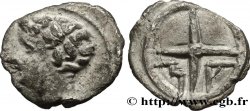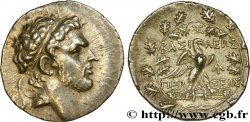v32_0804 - MASSALIA - MARSEILLE Litra au crabe - Avers au type du trésor d'Auriol à la tête d'Artémis
MONNAIES 32 (2007)
Starting price : 280.00 €
Estimate : 450.00 €
Realised price : 320.00 €
Number of bids : 2
Maximum bid : 320.00 €
Starting price : 280.00 €
Estimate : 450.00 €
Realised price : 320.00 €
Number of bids : 2
Maximum bid : 320.00 €
Type : Litra au crabe - Avers au type du trésor d'Auriol à la tête d'Artémis
Date: c. 470-450 AC.
Mint name / Town : Marseille (13)
Metal : silver
Diameter : 10 mm
Orientation dies : 5 h.
Weight : 0,81 g.
Rarity : R3
Coments on the condition:
Monnaie bien frappée et bien centrée, avec un droit complet mais de frappe un peu grasse. Beau crabe au revers mais sur un fond un peu flou. Fine patine grise
Obverse
Obverse legend : ANÉPIGRAPHE.
Obverse description : Tête d'Apollon au krobylos (?) à gauche.
Reverse
Reverse legend : ANÉPIGRAPHE.
Reverse description : Crabe vu de dessus ; grènetis.
Commentary
Ces litra semblent être les seules monnaies au crabe en Gaule, alors que cet animal est relativement courant en numismatique grecque. Le droit est très proche des monnaies à la tête d'Artémis du type des n° 500 et 501 de MONNAIES XXVIII qui présentent un carré creux au revers. Ces monnaies sont vraisemblablement contemporaines et il serait intéressant de retrouver des liaisons de coin entre ces séries !.








 Report a mistake
Report a mistake Print the page
Print the page Share my selection
Share my selection Ask a question
Ask a question Consign / sell
Consign / sell
 Full data
Full data















